- Speedmaster
“Moonwatch” Movements:
|
|
Background
information
|
- Written by
Chuck
Maddox
 on 29 June 2001,
on 29 June 2001,
- Last Revised: 21
November, 2006, 21:05 GMT
- Certain
Rights Reserved...
Recently
in the Omega Forum we had a request for some background
information on the movement Omega uses with the Speedmaster
Professional “Moonwatch”... As we do get this type
of request from time to time, I decided to expand and
elaborate my initial response and preserve it for future
reference/referral.
|
Index/Shortcuts
|
- Introduction
- The
Initial Query
- The
c.321
(a.k.a Lemania 2310/2320)
- The
c.861 (Lemania 1873) family
- Distinguishing
between 321/861's
- Calibre
Listing:
 c.863,
c.864,
c.866,
c.867 c.863,
c.864,
c.866,
c.867- 18th_Jewel
/ Yellow Gilt,
Rhodium,
New
Nomenclature
- Acknowledgments,
Fair Use Provisions
|
|
The
Initial Query:
|
- The
movement in the moonwatch... has it another background
(has it any roots in a Lemania or another brand)...
thanks in advance!
- Yes, it does... But which
one depends on which movement specific moonwatch movement
you are talking about.
-
- Over the years two main
movements have been used in the watch that Omega calls
"the Moonwatch"... The Omega c.321 and the Omega c.861
family...
|
|
The
c.321 (a.k.a. Lemania 2310/2320):
|
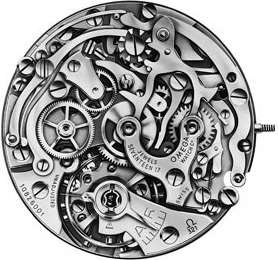 -
- The c.321 is based on a
design development project titled "27 CHRO C12" (27 mm
diameter, chronograph, with extra 12-hour register) took
place in the 1940's by Albert Piguet and Jaques Reymond
as a joint developement project between Omega and
Lemania. Launched in 1942, the 27 CHRO C12 later
became known as the Lemania 2310, or Omega
c.321).
It was used not only in the
Omega Speedmaster from 1957 through middle 1965 but also the
renamed and re-cased Omega Speedmaster Professional from
middle 1965 through middle October 1968, but also in
DeVille, Seamaster and non-model marked chronographs during
this era. It also was used in Omega non-model marked
Chronographs earlier in the 1950's under the 27 CHRO C12
calibre name...
|
|
The
c.861 family (a.k.a. Lemania 187x family)...
|
-
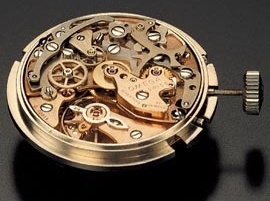
-
- The c.861 was developed by
Lemania starting in 1965. As nothing is created in a
vacuum, the Lemania 2310 was likely used as a
starting point for the development of the new
calibre...
-
- Changes from the Lemania
2310/Omega c.321 to the c.861 included:
-
- The chronograph function
was simplified from column wheel to a Shuttle/Cam system.
- The balance wheel was
changed from a screwed balance to a smooth balance
- This allowed an increase in
the frequency from 18,000 bph (2.5 HZ) to 21,600 bph (3
HZ)
- A flat balance spring was
utilized...
- Another change was made to
the shape of the bridge from it's previous "Arched",
"Wishbone" or "Y" shape to a Trapezoidal
shape...
- The revised movement was
accepted for use by Omega, who started equipping
Speedmasters in the October/November 1968 timeframe. The
revised movement is known as the Lemania 1873 or
Omega 861.
Here is a couple of pictures
that I have modified to illustrate the main ways to
distinguish between these two movements:
|
|
Distinguishing
between c.321 and a c.86x based movements...
|
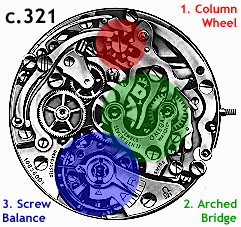
|

|
|
Omega c.321
(Lemania c.2310) movement
|
Omega
c.1863 (Lemania c.1873)
movement
|
|
|
Note:
This movement is actually a c.1863 (see
below)
|
- Since the introduction of
the c.861 there have been a few changes to the basic
movement. However, there is a reason why I call this
movement the "c.861 family"...
-
|
|
Listing
of c.861 related calibre's produced through the
years...
|
|
|
Calibre:
|
Comments:
|
|
c.863:
|
Starting with a
comemorative edition in 1980 marking the 10th
anniversary of the Apollo 11 lunar landing Omega
used a highly decorated version of the c.863
movement with Côtes de Genéve on the
bridge in conjunction with a special crystal
display back to show off the movement. In 1987 the
Display back model became part of the product line.
Current Display Back models use the Rhodium plated
c.1863 movement (see
below)...
|
|
c.864:
|
A special chronometre
grade version of the base c.861 movement has been
made available for limited production runs for
commemorative models off and on from 1992 through
1994 (at least).
|
|
c.865:
|
For some unknown
reason (perhaps wishing to create an association)
Omega named the Chronostop movement the c.865. The
Chronostop has no real relation to the other
models in the c.86x line other than Omega made and
sold them.
|
|
c.866:
|
A moonphase calendar
complication version of the base c.861 has been
produced for a special production run of 2,000 in
1985. Omega recently sold a white gold/white dial
version of the moonphase and currently has a
stainless steel/white dial version, both of which
use the new Rhodium
(c.1866) version
of the c.866 movement.
|
|
c.867:
|
A specially prepared
hand made version of the c.861 made in 1994, that
is a full-skeleton version of the c.861 created to
commemorate the 50th anniversary of the hand-wound
chronograph movement. Production was limited to 50
units...
|
|
|
The
18th Jewel / Switch from a "Copper" colored Gilt to
Yellow:
|
In November 2006 there was a thread over at the
Watch-U-Seek Omega forum where member GBonanno queried:
"Where and Why" did Omega/Lemania add this additional
jewel. Members rbt, jmsrolls (Fr. John even emailed me
asking me if I knew the answer: I only knew the what and
when, not the where and why), were among those who
participated in the discussion, but forum moderator Eptaz
sleuthed out the difference and posted a
picture:-
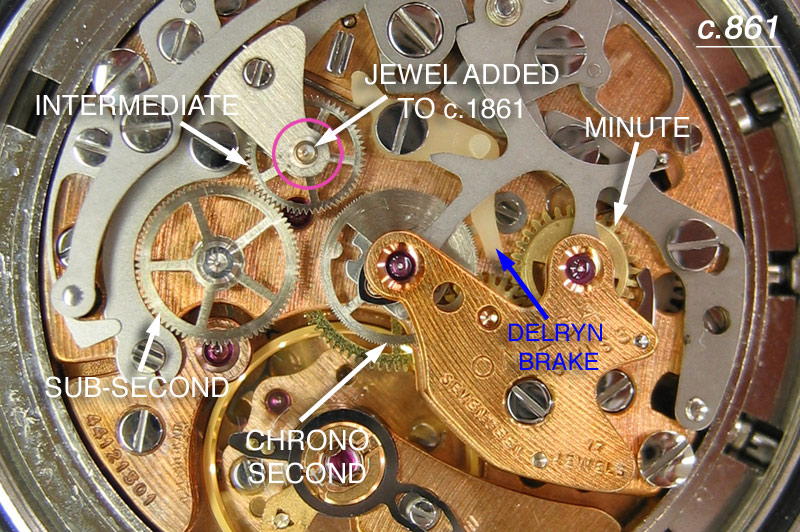 [Photo
credit Eptaz] [Photo
credit Eptaz]
-
- Now, if you compare the
part indicated inside the purple circle within the scan
above, and compare with the picture provided by Eric's
(Eptaz) fellow WUS moderator Strela below:
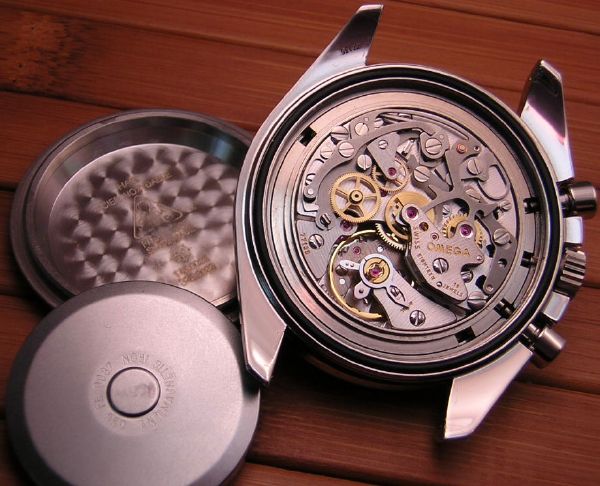 [click
on picture above to open full sized version in a new
window for side-by-side comparision, photo credit
Strela]
You'll see that it
certainly appears that this is where the 18th Jewel is
located...
It appears from looking at
Serial Numbers on various watches it appears that the 18th
Jewel was added several years prior to the switch to Rhodium
plating (discussed below). We also know that Omega switched
from a Coppery colored Gilt Plating sometime in the
1992/1993 epoch. One would think that Omega probably did
this switch around the same time.
However, there seems to be
little rhyme or reason around the transition... I own for
example, a display back model with an Apollo XI caseback
(which points towards an earlier example) marked 17 Jewels,
but it has the 18th Jewel, and is plated in a Gilt that
looks more yellow than coppery to me. Which could mean
several things: One, perhaps mine is a put-together, Two,
perhaps Omega wasn't especially discriminate about assembly
of parts and put some 18 jewel movements in watches with
plates marked 17 Jewels. Interestingly enough, Eric (Eptaz)
in an IM to me said that the person who first asked the
question over at Watch-U-Seek had a displayback Speedmaster
with the same configuration as my watch, so it might well be
that Omega made some this way. I don't know, but it's very
interesting.
OUTSTANDING detective work,
Eric and my thanks go to all the folks who participated in
that discussion over at WUS. I only wish I had known about
it while it was goin' on!
|
- From
Gilt to Rhodium...
|
Starting in 1997 Omega changed the content of the
movements it has put into the Speedmaster Professionals
in two immediately noticeable and significant
ways...
The movement was plated in Pink
gold to begin with, then yellow-gold from 1992, then
rhodium-plated in 1996. In 1996 the movement was renamed and
re-launched as the c.1861 and is still manufactured today. A
single part was changed from a metal component to a
nylon-like synthetic part which wears better and is
self-lubricating in all calibres except the display back
model, with it the original metal part is retained because
Omega didn't want display-back owners seeing the synthetic
part. Additionally, a single additional jewel has been added
bringing up the jewel count up to 18 from the 17 in previous
calibres.
|
|
Nomenclature
Change:
|
-
To differentiate earlier gilt movements from Rhodium
ones, Omega calls the Rhodium versions c.186x... So the
Rhodium version of the c.861 is called the c.1861, the
c.863 is called the c.1863, the c.866 is called the
c.1866, and so on...
-
- To see the difference
between these two different generations of movement
examine this side by side pictoral:
- c.863
Display Back
|
|
- c.1863
Display Back
|
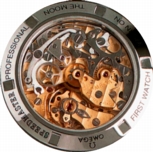
|
|
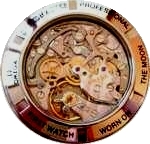
|
- Photo
from an Omega catalog provided by Adam
Gonzales
- (click
to enlarge)
|
|
- Photo
by Keith Downing
- (click
to enlarge)
|
|
|
Summary:
|
-
I hope this helps you to understand some of the
differences between these two base "Moonwatch"
movements...
-
- Having said all this, Omega
has used several other movements (Omega c.1040, and
several LCD Quartz) that it has marketed with the
"Speedmaster Professional" moniker, and has sold at least
one other model (the Speedmaster Day-Date Automatic
c.1045 Case Ref. 376.0822) with a case nearly
indistinguishable from the moonwatch case by the casual
observer, but that's a tangent to the basic
topic...
-
- Cheers!
-- Chuck
|
|
Acknowledgments:
|
-
I would like to thank the
following people for their interest, efforts and
contributions to this article:
- Keith Downing for his
contribution of a photo for an earlier article I wrote on
Speedmaster
Casebacks, which I
have recycled here.
- Adam Gonzales who sent me a
1996 Omega Catalog that I was able to scan a picture of a
c.863 movement for the aforementioned article
on Speedmaster Casebacks...
- Dov from the Omega Forum
for taking the time to email me some
suggestions.
- The participants over at
Watch-U-Seek.com's Omega forum for the query, detective
work and answer of the 18th Jewel riddle.
- Especially Eptaz and
Strela.
- The folks in the
TimeZone.com Omega Forum to numerious to mention here who
posted suggestions to me in the forum...
|
|
Statement
of rights retained and permissions granted...
|
-
Permission is granted for Eric
Katoso, Damon, Derek Ziglar, Frank N., Ross or Robert Jan
to include portions within the FAQ's they are writing as
long as credit (and a link to this article) is given.
Permission for personal, educational or noncommercial use
is granted. The author retains all other rights not
specifically mentioned here... For all other use please
contact
the author.
-
Disclaimer: Opinions
expressed are my own and knowing me should be taken with a
grain or two of salt...
|




 [Photo
credit Eptaz]
[Photo
credit Eptaz]

